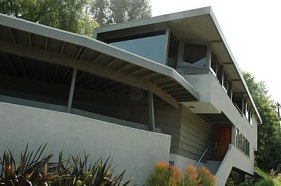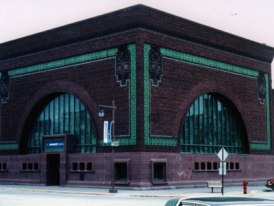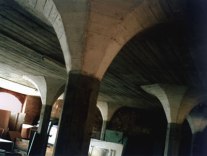Sunday May 4, 2008, 7:00 pm
At the Egyptian Theater in Hollywood
Los Angeles Filmforum presents
Southern California Video: Bruce and Norman Yonemoto
Filmforum highlights the work of four artists whose work cries out for more exhibition – significant pieces by fine artists of their media. In the second evening of four, we host Bruce and Norman Yonemoto, the Yonemotos will present several works, old and new.
California-based artists Bruce and Norman Yonemoto deconstruct and rewrite the hyperbolic vernacular with which the mass media constructs cultural mythologies. Ironically employing the image-language and narrative syntax of popular forms, such as soap opera, Hollywood melodrama and TV advertising, they work from “the inside out” to expose the media’s pervasive manipulation of reality and fantasy.
For more on the Yonemotos, click here or here.
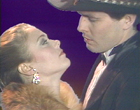 Vault (1984, 11:45 min, color, sound) Directed and edited by Norman Yonemoto. In this tour-de-force of stylized deconstruction, the Yonemotos rewrite a traditional narrative of desire — boy meets girl, boy loses girl. Employing the hyperbolic, melodramatic syntax of Hollywood movies and commercial TV, they decode the Freudian symbology and manipulative tactics that underlie media representations of romantic love, and expose the power of this media “reality” to construct personal fictions. Using the psychoanalytic language of advertising, cinematic and television texts to tell the love story of a pole vaulter/concert cellist and a cowboy/Abstract Expressionist painter, they rupture the narrative with psychosexual metaphors and references to pop media and art. Self-conscious strategies such as overtly Freudian symbols, flashback reconstructions of childhood traumas, Wagnerian orchestration and loaded cliches are wielded with deft irony. Vault, which has been termed a “deadpan homage to Bunuel’s amour fou melodramas,” critiques and celebrates the artifice of mass media mythologies.
Vault (1984, 11:45 min, color, sound) Directed and edited by Norman Yonemoto. In this tour-de-force of stylized deconstruction, the Yonemotos rewrite a traditional narrative of desire — boy meets girl, boy loses girl. Employing the hyperbolic, melodramatic syntax of Hollywood movies and commercial TV, they decode the Freudian symbology and manipulative tactics that underlie media representations of romantic love, and expose the power of this media “reality” to construct personal fictions. Using the psychoanalytic language of advertising, cinematic and television texts to tell the love story of a pole vaulter/concert cellist and a cowboy/Abstract Expressionist painter, they rupture the narrative with psychosexual metaphors and references to pop media and art. Self-conscious strategies such as overtly Freudian symbols, flashback reconstructions of childhood traumas, Wagnerian orchestration and loaded cliches are wielded with deft irony. Vault, which has been termed a “deadpan homage to Bunuel’s amour fou melodramas,” critiques and celebrates the artifice of mass media mythologies.
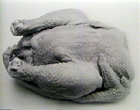 Blinky (1988, 15:30 min, color, sound) by Bruce and Norman Yonemoto and Jeffrey Vallance. Writes Bruce Yonemoto, “In the novella Blinky The Friendly Hen (1978), artist Jeffrey Vallance documented the supermarket purchase of a frozen chicken and its burial in the Los Angeles S.P.C.A. Pet Memorial Park. Naming the fryer Blinky, Vallance transformed poultry into pet, paying tribute to the billions of hens sacrificed each year for our consumption. Ten years later questions of the true cause of Blinky’s death continue to swirl. Blinky, the videotape, documents the search for this cause. Alas, like the shroud of Turin, Blinky’s death cannot be completely resolved. Blinky’s ten-year story ends where it began, in our culture’s glistening, dreamlike symbol of heavenly closure, the supermarket.”
Blinky (1988, 15:30 min, color, sound) by Bruce and Norman Yonemoto and Jeffrey Vallance. Writes Bruce Yonemoto, “In the novella Blinky The Friendly Hen (1978), artist Jeffrey Vallance documented the supermarket purchase of a frozen chicken and its burial in the Los Angeles S.P.C.A. Pet Memorial Park. Naming the fryer Blinky, Vallance transformed poultry into pet, paying tribute to the billions of hens sacrificed each year for our consumption. Ten years later questions of the true cause of Blinky’s death continue to swirl. Blinky, the videotape, documents the search for this cause. Alas, like the shroud of Turin, Blinky’s death cannot be completely resolved. Blinky’s ten-year story ends where it began, in our culture’s glistening, dreamlike symbol of heavenly closure, the supermarket.”
Kappa (1986, 26 min, color, sound) By Bruce and Norman Yonemoto in collaboration with Mike Kelley. Kappa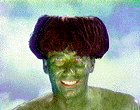 is a boldly provocative and original work. Deconstructing the myth of Oedipus within the framework of an ancient Japanese folk story, the Yonemotos craft a highly charged discourse of loss and desire. Quoting from Bunuel, Freud, pop media and art, they place the symbology of Western psychosexual analytical theory into a cross-cultural context, juxtaposing the Oedipal and Kappa myths in a delirious collusion of form and content. The Kappa, a malevolent Japanese water imp, is played with eerie intensity by artist Mike Kelley; actress Mary Woronov plays Jocasta as a vamp from a Hollywood exploitation film. Steeped in perversions and violent longings, both the Kappa and Oedipus legends are presented in highly stylized, purposefully “degraded” forms, reflecting their media-exploitative cultural contexts. In this ironic yet oddly poignant essay of psychosexual compulsion and catharsis, the Yonemotos demonstrate that even in debased forms, cultural archetypes hold the power to move and manipulate.
is a boldly provocative and original work. Deconstructing the myth of Oedipus within the framework of an ancient Japanese folk story, the Yonemotos craft a highly charged discourse of loss and desire. Quoting from Bunuel, Freud, pop media and art, they place the symbology of Western psychosexual analytical theory into a cross-cultural context, juxtaposing the Oedipal and Kappa myths in a delirious collusion of form and content. The Kappa, a malevolent Japanese water imp, is played with eerie intensity by artist Mike Kelley; actress Mary Woronov plays Jocasta as a vamp from a Hollywood exploitation film. Steeped in perversions and violent longings, both the Kappa and Oedipus legends are presented in highly stylized, purposefully “degraded” forms, reflecting their media-exploitative cultural contexts. In this ironic yet oddly poignant essay of psychosexual compulsion and catharsis, the Yonemotos demonstrate that even in debased forms, cultural archetypes hold the power to move and manipulate.
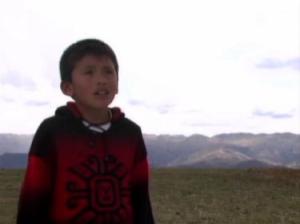 Sounds Like the Sound of Music (2005, 3.30 min, video) by Bruce Yonemoto. Sounds Like The Sound of Music (2005) draws from two distinct and seemingly unrelated Hollywood film classics, George Lucas’ Star Wars trilogy (specifically, the Reagan-era Return of the Jedi) and Robert Wise’s 1965 musical, The Sound of Music. Both films express Hollywood’s associations to political narratives of their times: The Sound of Music dramatized Post-War nostalgia for European ideals at the dawn of the Nazi regime; and Star Wars’ depiction of the “good vs. evil” ethos surrounding the final years of the Cold-War era. These relationships to war and cultural imperialism are of great interest to Yonemoto, especially when filtered through the Hollywood entertainment machine.
Sounds Like the Sound of Music (2005, 3.30 min, video) by Bruce Yonemoto. Sounds Like The Sound of Music (2005) draws from two distinct and seemingly unrelated Hollywood film classics, George Lucas’ Star Wars trilogy (specifically, the Reagan-era Return of the Jedi) and Robert Wise’s 1965 musical, The Sound of Music. Both films express Hollywood’s associations to political narratives of their times: The Sound of Music dramatized Post-War nostalgia for European ideals at the dawn of the Nazi regime; and Star Wars’ depiction of the “good vs. evil” ethos surrounding the final years of the Cold-War era. These relationships to war and cultural imperialism are of great interest to Yonemoto, especially when filtered through the Hollywood entertainment machine.
Filmed in Cuzco, Peru, Yonemoto’s video recreates the opening sequence from The Sound of Music, replacing the Austrian Alps with the Peruvian Andes, the village of Salzberg with Incan ruins and Julie Andrews with a young Andean boy. Sweeping aerial views and a solitary figure accompany the soundtrack, sung by the Andean boy. His song is a translated version of Rodgers and Hammerstein’s infective melody into the indigenous Incan language of Quechua, spoken by 13 million people throughout the Andes and South America. Yet the language is probably best known through its place in popular culture; George Lucas’ villain Jabba the Hut (an icon of “Orientalized” evil; a late-Twentieth-Century Godzilla), spoke this disappearing language.
Yonemoto’s work further complicates binary approaches to expressing post-Colonialism by incorporating many ingredients: escapist Hollywood cinema and aspirational Broadway musicals; youth culture and optimism; landscape and cultural artifact; indigenous voices and melodic universality; Europe, Asia, and the Americas; Pre-War, Post-War and Cold War. The resulting mixture is equally complex: beauty and romance, memento and memorial, personal and political.
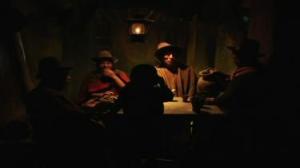 Papa (the original potato eaters) (2006, 11:14 min, video) by Bruce Yonemoto. Papa (the original potato eaters) is a new media installation by Bruce Yonemoto. Potatoes, indigenous to the farmlands of Andean Peru serve as the principle metaphor in this revisionist documentary. Papa replicates Vincent Van Gogh’s original composition, The Potato Eaters. The “uncivilized, unpeeled dusty faces” of the original Dutch peasants are portrayed by an indigenous Andean Quechua gamily who continue to this day “to earn their meals honestly.”
Papa (the original potato eaters) (2006, 11:14 min, video) by Bruce Yonemoto. Papa (the original potato eaters) is a new media installation by Bruce Yonemoto. Potatoes, indigenous to the farmlands of Andean Peru serve as the principle metaphor in this revisionist documentary. Papa replicates Vincent Van Gogh’s original composition, The Potato Eaters. The “uncivilized, unpeeled dusty faces” of the original Dutch peasants are portrayed by an indigenous Andean Quechua gamily who continue to this day “to earn their meals honestly.”
The Potato Eaters by Vincent Van Gogh has been called his first masterpiece. Painted in 1885, Van Gogh, like the French master Jean-François Millet, wanted to be a true “peasant painter.” This meant Van Gogh tried to paint his subjects with deep feeling, but without sentimentality. He spoke of them leading “a way of life completely different from ours, from that of civilized people.” He strove to paint the faces, “the color of a good, dusty potato, unpeeled naturally,” and to convey the idea that these people had “used the same hands with which they now take food from the plate to dig the earth […] and had thus earned their meal honestly.” (excerpted from the Van Gogh Museum catalogue)
Frederic Jameson in his writing The Deconstruction of Expression wrote that “in Van Gogh [the painting], that content, those initial raw materials, are, I will suggest, to be grasped simply as the whole object world of agricultural misery, of stark rural poverty, and the whole rudimentary human world of backbreaking peasant toil, a world reduced to its most brutal and menace, primitive and marginalized state.”
Following, the model of Luis Bunuel’s landmark 1932 surrealist documentary, Land Without Bread (Las Hurdes), Papa (the original potato eaters) attempts to parody the discourse typically adopted by the ‘voice of god’ documentary form, simply by bringing the underlying elitism of such formalism to the foreground – the distance that is inherent to ‘objectivity’ is revealed merely as cynicism.
Yonemoto has written, “For the great Irish potato famine to Van Gogh’s dark painting, the potato has represented misery. Why should a life of living from the land be one of misery? The prevalent documentary content of ‘marginalized peasant misery’ will be the central image under scrutiny. Does a documentary made in the West always have to portray people of the third world as being unhappy? Papa (the original potato eaters) presents a contemporary Peruvian family whose modest lives contrast with Van Gogh’s representation of stark rural poverty and Jamesons’ whole object world of agricultural misery.”
Video teaser can be viewed here.
A Norman Yonemoto Clip Joint (2007, 20 minute clip of a 45 minute video), by Norman Yonemoto. Clip Joint is a video assemblage of clips and short sequences from motion pictures mostly produced before 1964. Yonemoto isolates these clips from their predominantly Hollywood movie context and creates a new narrative with its own unique logic and meaning.
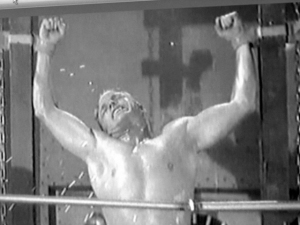 The polished surface of Hollywood classic movies creates a hyperbolic dream state of surprising complexity no matter how shallow the movies’ content may be. Perfected by an army of artists and technicians of the early Hollywood studio system from 1915 to 1929, these powerful images manipulate the movie-goers’ emotions as well as suspending their disbelief. Yonemoto blends these compelling images into a potent brew of self-reflection and deconstruction.
The polished surface of Hollywood classic movies creates a hyperbolic dream state of surprising complexity no matter how shallow the movies’ content may be. Perfected by an army of artists and technicians of the early Hollywood studio system from 1915 to 1929, these powerful images manipulate the movie-goers’ emotions as well as suspending their disbelief. Yonemoto blends these compelling images into a potent brew of self-reflection and deconstruction.



